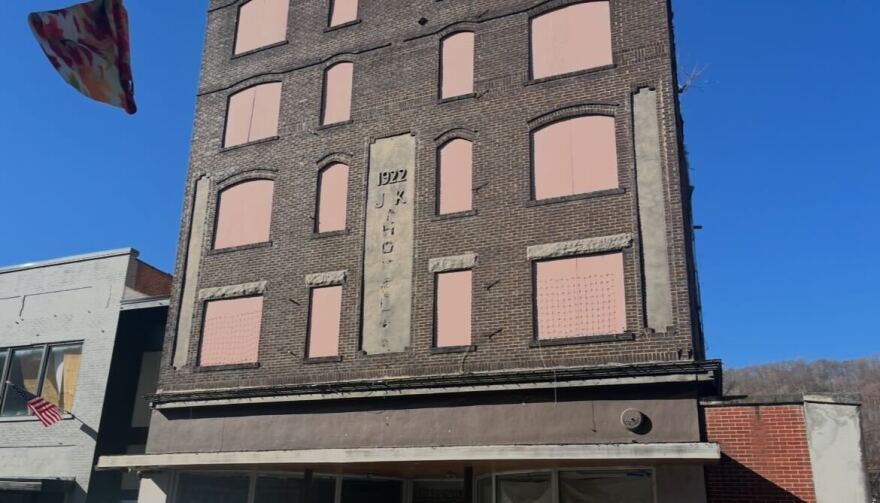Nestled in the southeastern Kentucky town of Harlan is Moonbow Tipple. It's a quaint, cozy coffee shop with space for chairs and sofas, rows of bookshelves and a small fireplace.
Hannah Clem, store manager and baker at Moonbow Tipple, has worked there since it opened in 2019.
"It's been going on six years, I guess, since we've been open here," she said. "But that was a big one, just to have the coffee shop, like a good coffee shop."
Harlan isn't dissimilar to other towns in the region. Famous for its significant coal production — and labor conflicts — in the 20th century, it has since experienced a loss of industry and population, leading to more vacant buildings.

According to Harlan Tourism, around a quarter of its downtown buildings were unoccupied in 2019. The town has since been filling vacancies, with 88% of its roughly 50 buildings occupied, and another 4% in development.
Moonbow Tipple is part of the handful of small businesses in Harlan trying to drive more people to the region. But these local storefronts are also necessary gathering places for locals.
"We have a big rush for teenagers, and they'll just hang out here waiting for their rides for hours," Clem said. "And it's more, I guess, having a place you can sit and just socialize and, you know, it's kind of a nice atmosphere."
Geoff Marietta owns Moonbow Tipple, along with a few other Harlan businesses. He recently announced his candidacy for mayor, but he's currently the interim executive director of ONE Harlan County, a local economic development nonprofit.
Much of his time has involved finding ways to reshape Harlan's economy after decades of decline.
"You had the opioid epidemic just ravaging communities in eastern Kentucky combined with the rapid decline of coal. And those two things came together. And then, of course, you layer in the housing bubble," Marietta said.
According to U.S. Census data, Harlan County had a population of 26,831 in 2020, down nearly 7,000 people from 2000.
Part of his plan to renew interest in Harlan includes opening "third spaces" where locals can gather, or for curious tourists to visit.
"You're seeing what post-diversification economy is starting to look like, and people are starting to say, 'Oh, wow. You know, we still have really great schools, we still have a very loving community, we still have beautiful mountains, we still have these things. And now, we have a good restaurant. Now we have a good coffee shop,'" Marietta said.
Other towns in eastern Kentucky have hired "Main Street" or "downtown" coordinators focusing on revitalizing their downtowns with events, community spaces and local fixtures.
Teresa Mays is the Main Street coordinator for Beattyville in Lee County. She said much of her work involves small businesses who have been there for decades.
"We don't have a Walmart here, we have local, small businesses," she said. "Because we're a small community, locals know the business owners, so if there's a specific need they have, they feel comfortable reaching out to the business owners."
Others say investing in the efforts makes towns more attractive for bringing in industry.
Bailey Richards, the former downtown coordinator for Hazard, now works with the Mountain Association, a nonprofit that invests in eastern Kentucky businesses.
"If you have a place where people want to live, then they will more than likely move their business there," Richards said. "But if it's a place that people don't necessarily want to live, they might come for a small period of time because of a tax incentive, or because of different things, but they may not stay forever."
During her time as coordinator starting in 2019, Hazard saw 74 businesses open their doors in their 130 commercial buildings downtown, with a 11% closure rate. The town also enacted a vacant property ordinance.
"What that did was it would identify vacant properties, blighted properties, abandoned properties, however you want to describe them, and it would give notice to those owners, and they would have a year to remedy whatever the issue was. And then if they didn't, then they would be charged at a higher tax rate within the city," Richards said.

Living in eastern Kentucky can come with challenges. Hazard was hit by floods both earlier this year, and in 2022. A Washington Post analysis says 11 of the 16 U.S. counties with the most frequently declared flooding disasters since 2004 have been in Kentucky.
"Choosing to be in the place that you love and the place that you want to be with, that makes it easier to want to rebuild," Richards said. "We know that these things are coming, they're coming more often, so now we just have to plan for them."
In Harlan, Marietta said a challenge is development without sacrificing the character of the town, or alienating locals. He said he's up to the task.
"I think Harlan County is very far from, you know, becoming a Pigeon Forge or a Gatlinburg," he said. "But you need to be intentional in your economic development efforts, if you do not want to move in that direction."
This story was produced by the Appalachia + Mid-South Newsroom, a collaboration between West Virginia Public Broadcasting, WPLN and WUOT in Tennessee, LPM, WEKU, WKMS and WKU Public Radio in Kentucky, and NPR.
Copyright 2025 WEKU






